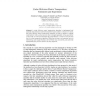Free Online Productivity Tools
i2Speak
i2Symbol
i2OCR
iTex2Img
iWeb2Print
iWeb2Shot
i2Type
iPdf2Split
iPdf2Merge
i2Bopomofo
i2Arabic
i2Style
i2Image
i2PDF
iLatex2Rtf
Sci2ools
ICCS
2004
Springer
2004
Springer
Cache Oblivious Matrix Transposition: Simulation and Experiment
A cache oblivious matrix transposition algorithm is implemented and analyzed using simulation and hardware performance counters. Contrary to its name, the cache oblivious matrix transposition algorithm is found to exhibit a complex cache behavior with a cache miss ratio that is strongly dependent on the associativity of the cache. In some circumstances the cache behavior is found to be worst than that of a naïve transposition algorithm. While the total size is an important factor in determining cache usage efficiency, the sub-block size, associativity, and cache line replacement policy are also shown to be very important.
| Added | 01 Jul 2010 |
| Updated | 01 Jul 2010 |
| Type | Conference |
| Year | 2004 |
| Where | ICCS |
| Authors | D. Tsifakis, Alistair P. Rendell, Peter E. Strazdins |
Comments (0)

